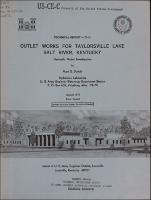Please use this identifier to cite or link to this item:
https://hdl.handle.net/11681/13595| Title: | Outlet works for Taylorsville Lake, Salt River, Kentucky : hydraulic model investigation |
| Authors: | United States. Army. Corps of Engineers. Louisville District Dortch, Mark S. |
| Keywords: | Hydraulic models Outlet works Stilling basins Taylorsville Lake (Ky.) Salt River Hydraulic structures Hydraulic gates Water quality Stilling basin Flood control |
| Publisher: | Hydraulics Laboratory (U.S.) Engineer Research and Development Center (U.S.) |
| Series/Report no.: | Technical report (U.S. Army Engineer Waterways Experiment Station) ; H-75-12. |
| Description: | Technical Report Abstract: Model investigation of the outlet works for Taylorsville Lake was concerned with verification and improvement of the hydraulic design of the intake structure, conduit, and stilling basin. The study was conducted on a 1:25-scale model of the outlet works which reproduced a portion of the approach area, the intake structure, the outlet conduit, the hydraulic-jump type stilling basin, and approximately 120 ft of exit channel. The proposed intake structure provided effective regulation of both flood-control and water-quality releases. Flow and pressure conditions were satisfactory for all expected operating schemes. However, certain extreme operational procedures must be avoided to prevent subatmospheric pressures in the throat section of the water-quality system and flow instabilities in the wet well during selective withdrawal and in the conduit during flood-control flow. Performance of the original design stilling basin was unacceptable as unstable hydraulic action in the basin resulted in poor energy dissipation. Eddy formation throughout the lower range of discharges was a difficult problem to overcome because of the relatively low elevation of the outlet portal invert with respect to the tailwater elevation. A humped trajectory with the central section raised higher than the sides (type 8 basin) diverted more flow to the sidewalls and eliminated eddying. The chute blocks and tapered training walls of the type 8 basin provided stable basin action with good energy dissipation. Single or uneven gate operation produced unbalanced flow in the stilling basin; however, the eddies were not as severe as in the original design. Since single gate operation is rarely necessary and should be avoided, the type 8 basin is considered to be acceptable for prototype construction. |
| Rights: | Approved for public release; distribution is unlimited. |
| URI: | http://hdl.handle.net/11681/13595 |
| Appears in Collections: | Technical Report |
Files in This Item:
| File | Description | Size | Format | |
|---|---|---|---|---|
| TR-HL-75-12.pdf | 4.94 MB | Adobe PDF |  View/Open |